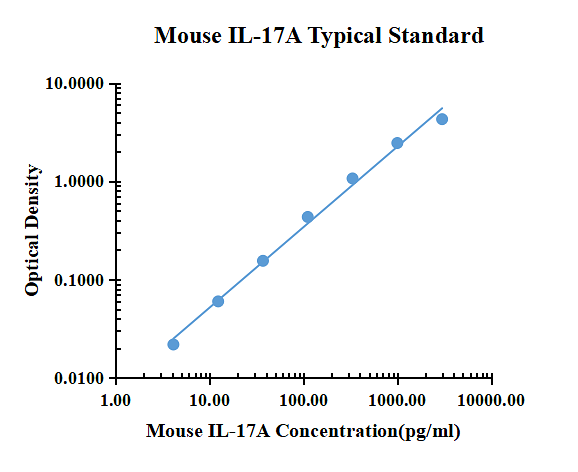Mouse IL-17A enzyme-linked immunoassay kit
| Specification | 96 Test |
|---|---|
| Sensitivity | 0.25 pg/ml (10 μl) |
| Standard Curve Range | 4.12~3000 pg/ml |
| Standard Curve Gradient | 7 Points/3 Folds |
| Number of Incubations | 2 |
| Detectable sample | Liquid phase sample of soluble substances. For example: serum, plasma, cell culture supernatant, tissue grinding liquid, etc. |
| Sample Volume | 10 μl |
| Type | Fully Ready-to-Use |
| Operation Duration | 120min |

| pg/ml | O.D. | Average | Corrected | |
|---|---|---|---|---|
| 0.00 | 0.0185 | 0.0190 | 0.0188 | |
| 4.12 | 0.0401 | 0.0410 | 0.0406 | 0.0218 |
| 12.35 | 0.0780 | 0.0793 | 0.0787 | 0.0599 |
| 37.04 | 0.1741 | 0.1738 | 0.1740 | 0.1552 |
| 111.11 | 0.4544 | 0.4513 | 0.4529 | 0.4341 |
| 333.33 | 1.0793 | 1.1009 | 1.0901 | 1.0714 |
| 1000.00 | 2.4751 | 2.4811 | 2.4781 | 2.4594 |
| 3000.00 | 4.2712 | 4.3698 | 4.3205 | 4.3018 |
Precision
| Intra-assay Precision | Inter-assay Precision | |||||
| Sample Number | S1 | S2 | S3 | S1 | S2 | S3 |
| 22 | 22 | 22 | 6 | 6 | 6 | |
| Average(pg/ml) | 40.2 | 254.7 | 867.4 | 43 | 235.5 | 947.6 |
| Standard Deviation | 1.9 | 8.7 | 39.6 | 1.7 | 7.6 | 44.7 |
| Coefficient of Variation(%) | 4.8 | 3.4 | 4.6 | 3.9 | 3.2 | 4.7 |
Intra-assay Precision (Precision within an assay) Three samples of known concentration were tested twenty times on one plate to assess intra-assay precision.
Inter-assay Precision (Precision between assays) Three samples of known concentration were tested six times on one plate to assess intra-assay precision.
Spike Recovery
The spike recovery was evaluated by spiking 3 levels of mouse IL-17A into health mouse serum sample. The un-spiked serum was used as blank in this experiment.
The recovery ranged from 76% to 108% with an overall mean recovery of 95%.
Sample Values
| Sample Matrix | Sample Evaluated | Range (pg/ml) | Detectable (%) | Mean of Detectable (pg/ml) |
|---|---|---|---|---|
| Serum | 30 | n.d.-21.67 | 33 | 6.01 |
Serum/Plasma – Thirty samples from apparently healthy mice were evaluated for the presence of IL-17A in this assay. No medical histories were available for the donors.
n.d. = non-detectable. Samples measured below the sensitivity are considered to be non-detectable.
Product Data Sheet
Background: IL-17A
Interleukin‑17A (IL‑17A), also known as CTLA‑8, is a 15‑20 kDa glycosylated cytokine that plays an important role in anti‑microbial and chronic inflammation. The six IL‑17 cytokines (IL‑17A‑F) are encoded by separate genes but adopt a conserved cystine knot fold. Mature human IL‑17A shares 60% amino acid sequence identity with mouse and rat IL‑17A. IL‑17A is secreted by Th17 cells, gamma /δ T cells, iNKT cells, NK cells, LTi cells, neutrophils, and intestinal Paneth cells. It forms disulfide‑linked homodimers as well as disulfide‑linked heterodimers with IL‑17F. IL‑17A exerts its effects through the transmembrane IL‑17 RA in complex with IL‑17 RC or IL‑17 RD. Both IL‑17 RA and IL‑17 RC are required for responsiveness to heterodimeric IL‑17A/F. IL‑17A promotes protective mucosal and epidermal inflammation in response to microbial infection. It induces chemokine production, neutrophil influx, and the production of antibacterial peptides. IL‑17A/F likewise induces neutrophil migration, but IL‑17F does not. IL‑17A additionally enhances the production of inflammatory mediators by rheumatoid synovial fibroblasts and contributes to TNF‑ alpha induced shock. In contrast, it can protect against the progression of colitis by limiting chronic inflammation. IL‑17A encourages the formation of autoreactive germinal centers and exacerbates the onset and progression of experimental models of autoimmunity. IL‑17A has been shown to exert either tumorigenic or anti‑tumor effects.

